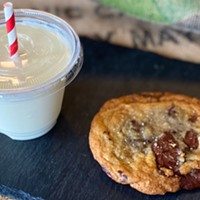The door to Dick Taylor Craft Chocolate's new digs (4 W. Fourth St., Eureka) is like a wormhole from Fourth Street's auto repair shops and motels into a hipster lodge. The woody cocoon of a showroom is more J. Crew than Willy Wonka, with a mounted buck and nautical rope in lieu of a river of chocolate. But the smell of the product, which two of the company's 10 employees are hand wrapping in gold foil and letterpress envelopes (seriously) in a corner, gives it away. Humboldt County's only "bean-to-bar" chocolate operation moved into the space, its sole facility, in February. Peer into the factory through a window for free, or $5 gets you a 45-minute tour (with a tasting, naturally) and a glimpse of how the 4-year-old company turns out its award-hogging bars with only cocoa and sugar. You can also browse a curated wall of chocolate the company doesn't make — from Iceland, Italy and Hungary. Co-founder Adam Dick recommends the $14 burnt sugar bar from Iceland. "We always want to get people hooked on chocolate," he says.
Pro-tip: Bring a hat, lest your guide smile apologetically and hand you a hairnet. Dick, in geometric glasses and company ball cap, leads us through to the less stylish garage, where his partner (and fellow member of the band Huckleberry Flint) Dustin Taylor is fixing a cabinet. Piled high by the door are burlap sacks of dried and fermented organic cocoa beans from overseas waiting to be sorted. Dick turns over a Mason jar of detritus picked out in sorting: rocks, corn, sticks, insects and a metal zipper.
Sorted beans go into an old, tricked-out coffee roaster. As Dick runs his hands through them we lean in for a smell: not chocolate yet, but fruity, acidic and nutty. In another bucket, roasted beans are a dark terra cotta with that rich, mellow cocoa aroma. He peels the husk off a cocoa like a peanut skin and explains how it's turned into garden mulch. That, too, smells fantastic. There is a platoon of white buckets filled with roasted beans, all labeled with place names: "Bolivia," "Madagascar." Dick acknowledges there is "an art" to making confections with "bought chocolate," but roasting and grinding gives the chocolatier control — especially important for single-origin bars that isolate the flavor of beans from a certain place for a certain time.
We head inside to see large machines painted cream to match the walls of what could pass for someone's industrial-chic SoHo loft, complete with barnwood doors and exposed beams. Dick introduces the silver hammermill that crushes cocoa nibs down to a sandy "liquor," which then takes a beating in the ball mill — a behemoth filled with ball bearings that smash the cocoa powder down to 20 microns, or about half the width of a human hair. Because there is no liquid vanilla, lecithin or milk, he explains, melding the sugar and cocoa into a smooth chocolate is tricky. The ball mill's no good for crystalline sugar (think of the uneven pieces of a thrown glass), so it's run through metal rollers with the cocoa to evenly break it down to the ultra-fine "flake" stage.
Dick pats the ivory exterior of the conch, which looks like an enormous food mill Martha Stewart would use to off enemies if she were a Bond villain. Its sweeping blades smear the flake and spread the cocoa butter around until, 48 hours later, it yields a chocolate paste ready to be tempered and shaped into bars.
Behind another window, two young men with bent necks feverishly shake trays to evenly fill three molds at a time. Today they'll add black fig to the bars. "I think initially, it was kind of a hobby," says Dick, smiling under his broom of a mustache. "As we got a little better at it, our friends said, 'You should sell it.'" The hardcore artisanal approach doesn't come cheap and, at $7 a bar with climbing cocoa and shipping costs, one wonders if this is the right economy for going pro. Dick says yes, and that high-end chocolate is "an affordable luxury," unlike 40-year-old Scotch, for example. "We're trying to make some of the best chocolate in the world. ... It's been a race to the bottom in terms of mass market quality."
Back in the storefront, we nibble chocolate from annotated sample jars. As with wine, descriptors for top-shelf chocolate can be overly precious. But damn if the Toledo bar isn't floral and plummy. Less subtle is the Los Bagels Slug Slime bar created for Humboldt State University — with garlicky notes of "everything" bagels. You are warned. Finally, we scoot up to the counter as Dick fills espresso cups at a kind of hot slushy machine that keeps sipping chocolate warm and moving. Today it is a thick mixture of milk and the Belize chocolate made a few yards from where we sit, but with the sweet, tart smokiness of somewhere far away.





Comments